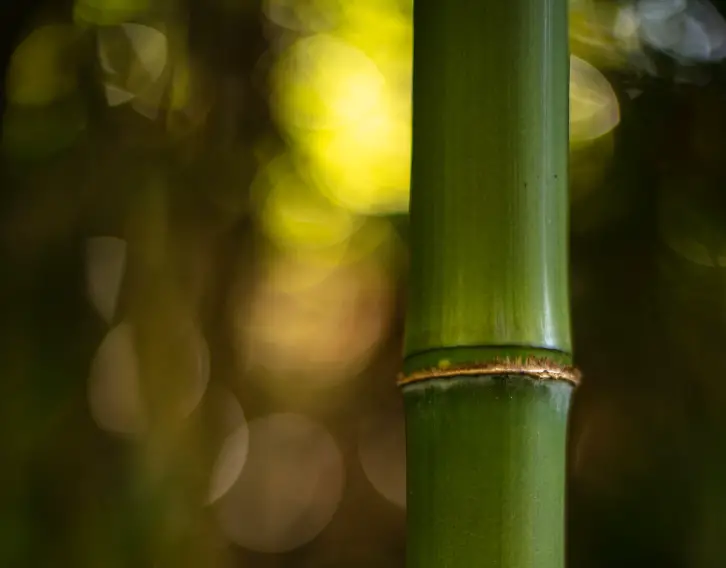By now you’ve probably heard a thing or two about the many virtues of bamboo: its versatility, its sustainability, and its indispensability. And you’ve no doubt admired its beauty, as it flourishes among pagodas in Japanese gardens, on the patios of Thai restaurants and sushi bars, and on-screen in some of your favorite kung fu movies.
But you may have also heard horror stories about people planting bamboo and soon finding it completely out of control. Perhaps a neighbor planted some and within a couple years it was all up in your flower bed choking out your roses and suffocating your award-winning bearded irises. Indeed, bamboo can be aggressive, sustainable in the worst kind of way, downright indestructible.
In order to select a bamboo that will add grace and beauty to your garden, rather than bringing you years of frustration, you need to learn a little bit about the subfamily Bambusoideae in the grass family Poaceae. You also need to take stock of your growing conditions to determine what sort of bamboo will do best in your space and climate. After all, the variety of bamboo species is enormous. With 1,200 to 2,000 distinct varieties, there’s a bamboo for literally every setting.
NOTE: This article first appeared in March 2019, last updated in January 2023.
Know your bamboo
So how can you ornament your garden with this incredible plant without running into deep regrets 3 or 4 years down the road?
Unless you really really know what you’re doing or really really don’t care, it might be better to keep your bamboo in a container. Bamboo looks great in pots, and in something like an old wine barrel it has plenty of room to prosper, without encroaching on your crocus or tickling your tulips.
For starters, you need to realize that there are some 1,500 varieties of bamboo, with various personalities and growth habits. People tend to divide them into two groups: runners and clumpers.
Running bamboo
Running bamboo sends out long, thin rhizomes, running horizontally away from the center of the plant. Botanists call these monopodial or leptomorph rhizomes. You can tear down the culms and dig out all the rhizomes you can find, but if you miss a few pieces, they will likely grow back.
Running bamboos often have the potential to run amok and take over your garden. They can also make your neighbors pretty nervous. But if you’re looking for something that will grow quickly and cover a large area, running bamboo is the way to go. Unless you have plenty of open space, however, you’ll want to keep these runner confined in a container, or with a heavy duty root barrier.
Clumping bamboo
Clumping bamboos, on the other hand, have thicker, u-shaped rhizomes, known as sympodial or pachymorph. Rather than sending long roots away from the core, these rhizomes generally tend to curve upward to send up new shoots. In this way they are easier to contain, and should it become necessary, much easier to remove.
To avoid being overrun by invasive grass, and most residential gardeners will prefer clumping bamboo that they can manage. Clumping bamboo varieties generally do better in warmer, more tropical habitats. For this reason, people in colder climates often end up growing runners, but there are a handful of clumping bamboos that can tolerate freezing, sub-zero temperature.
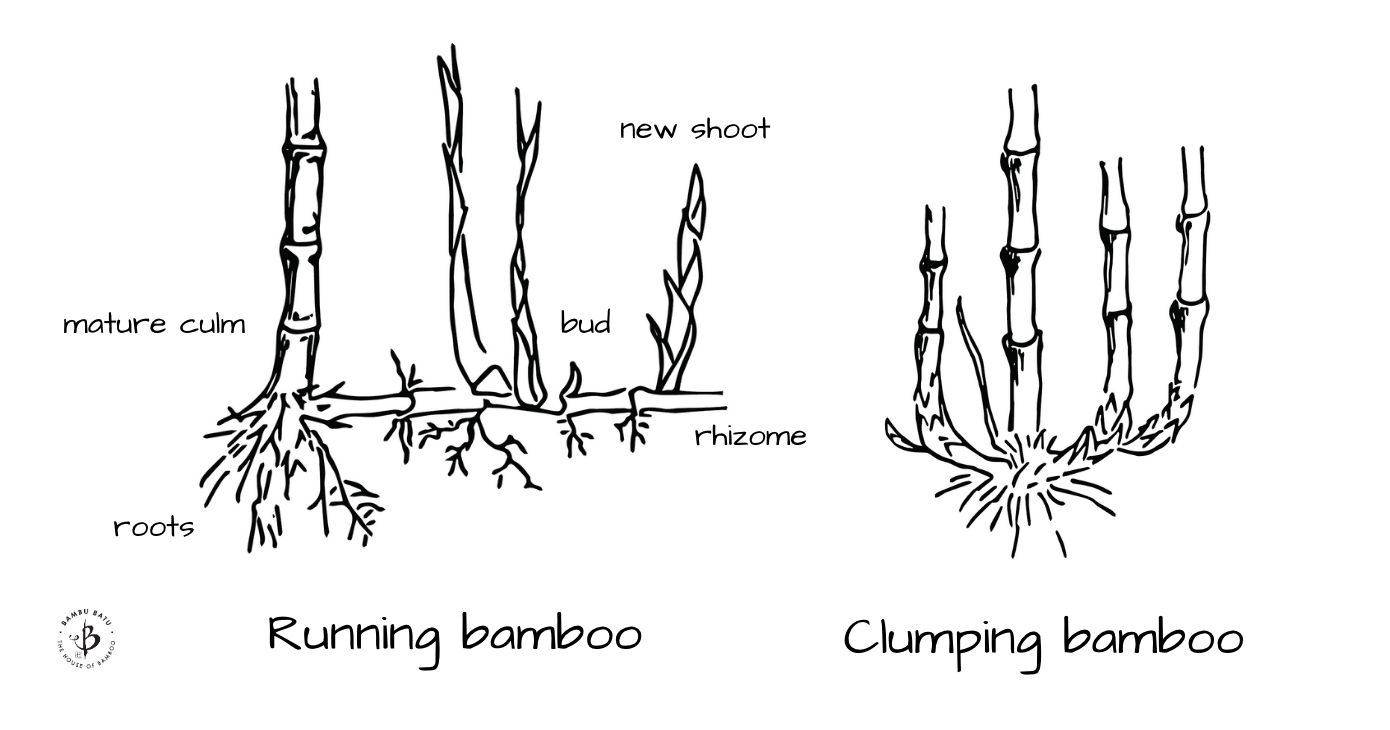
Identifying bamboo
This running and clumping division can be helpful, but dividing 1,500 species into two groups can also be a bit of an oversimplification. Some runners spread more slowly, and there are “open clumpers” that can end up spreading pretty far.
Climate and other growing conditions will also affect the plant’s behavior. If you plant a clumper alongside a regularly sprinkled lawn, the grassy clumper will quickly gravitate toward the sprinklers and start looking more like a runner. Likewise, if you plant a runner in a chilly climate like the high sierras or upstate New York, it might end up staying pretty compact.
Also, bamboos are notoriously difficult to identify. There are thousands of varieties, and most of them look pretty similar. Even nurseries get them mixed up, especially those that don’t specialize in bamboos. And it might take a few years for you to realize that your friendly clumper was really a pathological runner in disguise. We highly recommend sourcing your bamboo from a nursery that specializes in bamboo.
There’s an old saying about bamboo: The first year in sleeps, the second year it creeps, and the third year it leaps. Do not underestimate the Eastern wisdom! In the first couple seasons, your bamboo might look like it’s clumping. But once that underground network of rhizome roots gets a foothold, it can become an unstoppable force of nature. And by the third year, you may find yourself inundated with renegade bamboo shoots.
Choosing the best bamboo for your conditions
There are all kinds of reasons to grow bamboo, and myriad climates in which to grow it. So with all those species to choose from, you really want to assess your goals and conditions in order to plant the best species.
To make the process easier, we have produced a great series of articles about different bamboo characteristics and habitats with lists of recommended species. Take a look at these articles to help guide you through the selection process and direct you to the species that will best meet your needs.
Bamboos for different habitats:
- Growing bamboo in cold climates
- Growing bamboo in the shade
- Growing bamboo indoors
- Growing bamboo in the desert
- Growing bamboo in the water
Bamboos with specific features for different purposes:
- Bamboo for hedges and screens
- Timber bamboo
- Bamboos for construction
- Dwarf and ground cover bamboo
- Bamboos with stripes
- Bamboos with long internodes

A few of my favorite bamboo species
With that in mind, here are eight species of bamboo to consider for accenting your garden. These were the first kinds of bamboo I started growing on the Central Coast of California back in 2006. That’s when my love for bamboo really reached the next level. And from then on, there was no turning back.
Black Bamboo (Phyllostachys nigra)
One of the most highly sought-after species, black bamboo is named for the very dark color of its stalks. At maturity, this legendary runner can get up to an inch or two in diameter and as much as 30″ tall. With time, the elegant upright poles take on a deep, dark sheen that adds a little something special to any garden.
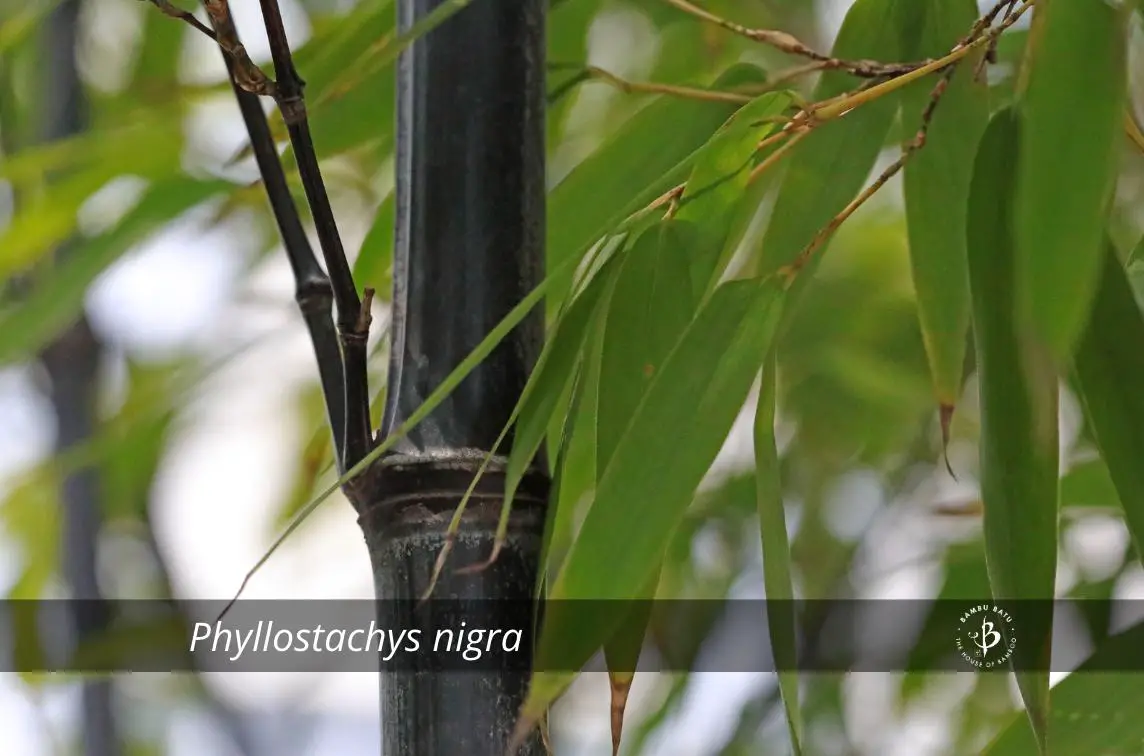
Mexican Weeping Bamboo (Otatea acuminata)
With its delicate, draping foliage, this clumping variety makes a nice ornamental accent. In a container, it’s unlikely to get taller than 6 feet. Native to Mexico, this bamboo is more drought-tolerant than most, but not especially cold-hardy.
Timber (Phyllostachys vivax)
Like every member of the genus Phyllostachys, this one is a runner. It’s popular for its great size. When planted in the ground and well fed it can get 4-5 inches in diameter and up to 60 feet tall. Vivax is also very hardy and resilient, in cold winters as well as hot, dry summers.
Temple Bamboo (Semiarundinaria fastuosa)
A personal favorite of mine, this regal looking bamboo grows very tall, straight and compact. Growing up to 20 or 30 feet high, and about 1.5″ in diameter, it’s not huge, but it is very attractive. Direct sunlight causes the culms to take on a striking shade of pink or magenta.
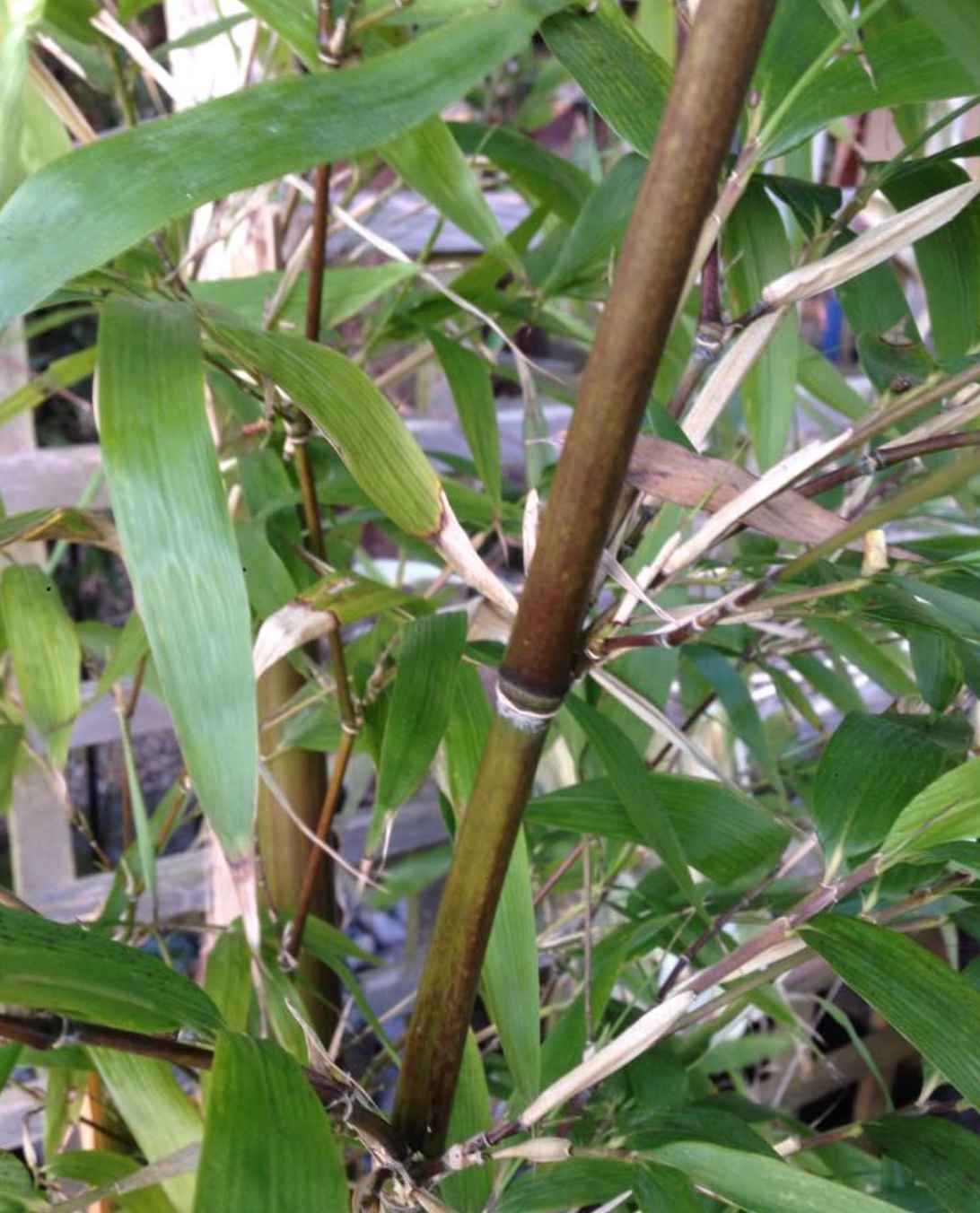
Arrow Bamboo (Pseudosasa Japonica)
Sometimes known as a “running clumper,” this makes an excellent privacy screen, tall and dense. It has running rhizomes, but they spread more slowly than most runners, especially when grown in the shade. It grows up to about 15 feet tall with thick foliage. Easily recognizable for its unusually large leaves – up to 12″ long.
Oldham’s (Bambusa oldhamii)
Another very popular variety, Oldham’s grows very tall and straight. A giant subtropical bamboo, it clumps tightly but grows vigorously. Poles commonly grow 50 or 60 feet tall. Despite being a tropical clumper, Oldham can withstand winter temperatures into the low 20s.
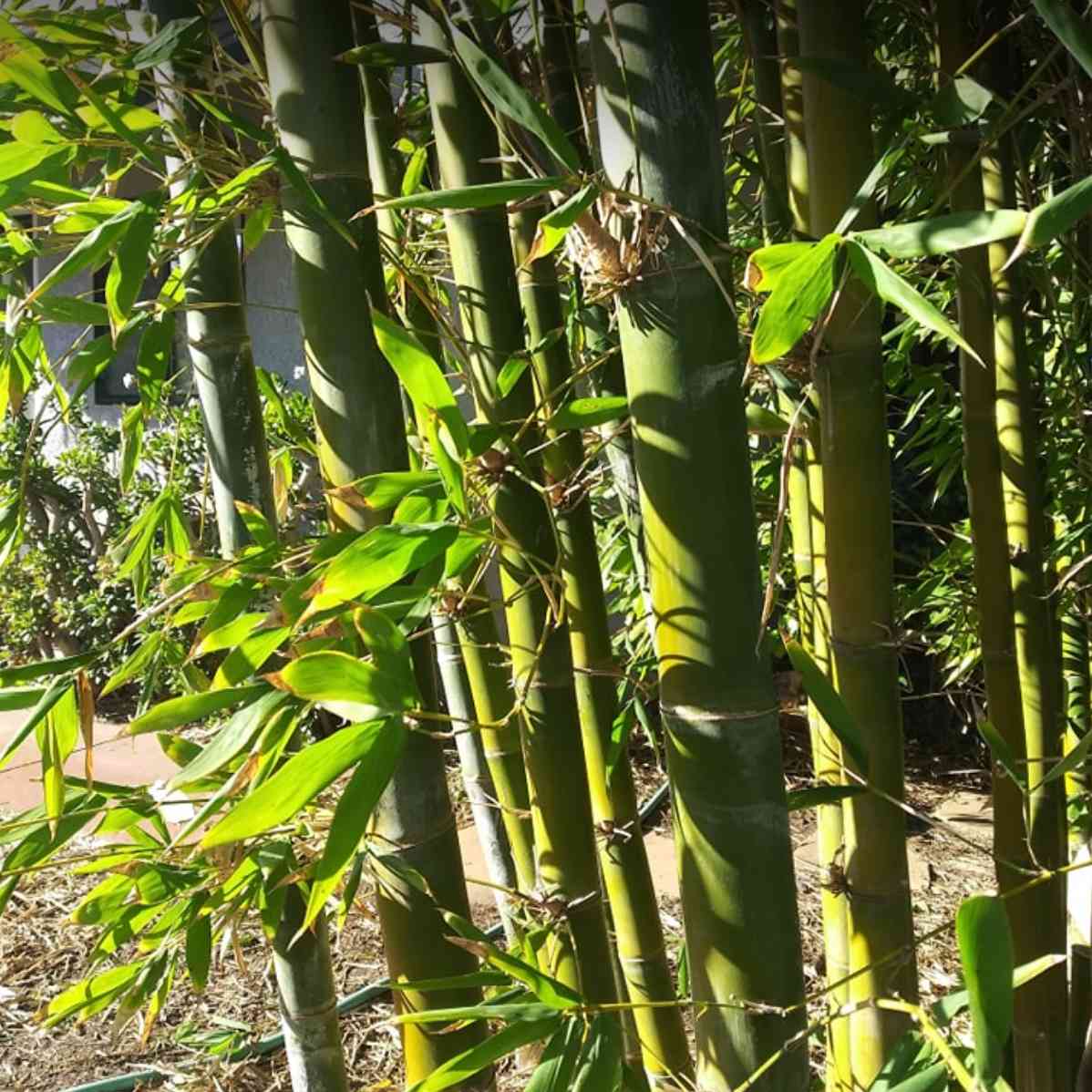
Golden Bamboo (Phyllostachys aurea)
One of the most popular varieties because it is so widely available. That’s because it’s an aggressive runner that’s easy to propagate. Good for a rapidly expanding privacy hedge, but very difficult to remove. Beware of infestations!
Square Bamboo (Chimonobambusa quadrangularis)
Especially interesting for its squarish (rather than round) culms. The unusual shape and upright growth habit make for an attractive hedge. The variety needs very regular water and doesn’t enjoy a hot, dry climate. Good choice for pots and containers.

Further reading
Now you’re ready to choose the best bamboo for your unique garden setting. To raise your knowledge of bamboo to expert level, check out some of our other popular articles.

